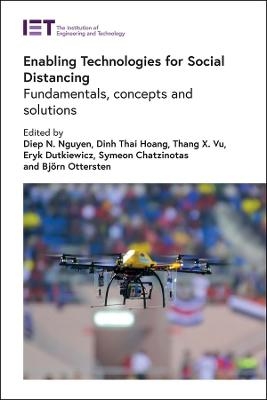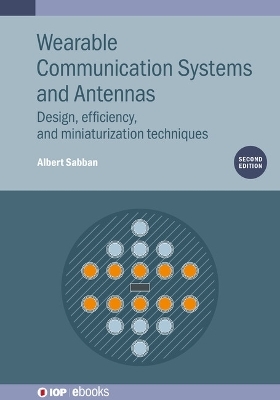
Enabling Technologies for Social Distancing
Institution of Engineering and Technology (Verlag)
978-1-83953-490-4 (ISBN)
The latest advances in several emerging technologies such as AI, blockchain, privacy-preserving algorithms used in localization and positioning systems, cloud computing and computer vision all have great potential in facilitating social distancing. Benefits range from supporting people to work from home to monitoring micro- and macro- movements such as contact tracing apps using Bluetooth, tracking the movement and transportation level of a city and wireless positioning systems to help people keep a safe distance by alerting them when they are too close to each other or to avoid congestion. However, implementing such technologies in practical scenarios still faces various challenges.
This book aims to lay the foundations of how these technologies could be adopted to realize and facilitate social distancing to better manage pandemics and future outbreaks. Starting with basic concepts, models and practical technology-based social distancing scenarios, the authors present enabling wireless technologies and solutions which could be widely adopted to encourage social distancing. They include symptom prediction, detection and monitoring of quarantined people and contact tracing. In the future, smart infrastructures for next-generation wireless systems should incorporate a pandemic mode in their standard architecture and design.
Diep N. Nguyen is a faculty member, Director of Agile Communications and Computing group, Faculty of Engineering and Information Technology, University of Technology Sydney (UTS), Australia. His research interests include 5G/6G, computer networking, and machine learning applications, with emphasis on systems' performance and security/privacy. He is a senior member of the IEEE, an associate editor of the IEEE Transactions on Mobile Computing, IEEE Access, Sensors Journal, and IEEE Open Journal of the Communications Society (OJ-COMS). Dinh Thai Hoang is a faculty member with the School of Electrical and Data Engineering, University of Technology Sydney, Australia. His research interests include emerging topics in wireless communications and networking such as machine learning, ambient backscatter communications, IRS, edge intelligence, cybersecurity, IoT, and 5G/6G networks. He is currently an editor of IEEE Transactions on Wireless Communications and IEEE Transactions on Cognitive Communications and Networking, and IEEE Communications Surveys and Tutorials. Thang X. Vu is a research scientist in the Interdisciplinary Centre for Security, Reliability and Trust, University of Luxembourg. His research interests include wireless communications, with particular interests in cache-assisted 5G, cloud radio access networks, machine learning for communications, and resources allocation and optimization. He holds a PhD degree in Electrical Engineering from the University of Paris-Sud, France. Eryk Dutkiewicz is a professor and head of the School of Electrical and Data Engineering, University of Technology Sydney, Australia. He has a joint professor appointment at Hokkaido University, Japan. He is also a co-director of the UTS-VNU Joint Research Centres in Hanoi and Ho Chi Minh City, Vietnam. He has been the PI on the 5G Dynamic Spectrum Sharing project and Ubiquitous Communications for 5G Networks project funded by Intel Corporation. Symeon Chatzinotas is full professor, chief scientist I and Head of the research group SIGCOM in the Interdisciplinary Centre for Security, Reliability and Trust, University of Luxembourg. His research interests cover multiuser information theory, cooperative/cognitive communications, cross-layer wireless network optimization and content delivery networks. He has contributed to numerous R&D projects. He has co-edited and authored several scientific books. Björn Ottersten is director of the Interdisciplinary Centre for Security, Reliability and Trust at the University of Luxembourg. His research interests include signal processing, wireless communications, radar and computer vision. He has been digital champion of Luxembourg, acting as adviser to the European Commission and also member of the Boards of the Swedish Research Council and the Swedish Foundation for Strategic Research. He has served as editor in chief of EURASIP Signal Processing.
Chapter 1: Social distancing and related technologies: fundamental background
Chapter 2: Background on positioning and localization for social distancing
Chapter 3: Wireless and networking technologies for social distancing - indoor and outdoor
Chapter 4: Computer vision technologies for social distancing
Chapter 5: Artificial intelligence and big data for COVID-19 and social distancing
Chapter 6: Advanced sensing and automation technologies
Chapter 7: Security, privacy and blockchain applications in COVID-19 detection and social distancing
Chapter 8: Real-time optimization for social distancing
Chapter 9: Incentives for individual compliance with pandemic response measures
Chapter 10: Open issues and future research directions
| Erscheinungsdatum | 19.07.2022 |
|---|---|
| Reihe/Serie | Telecommunications |
| Verlagsort | Stevenage |
| Sprache | englisch |
| Maße | 156 x 234 mm |
| Themenwelt | Technik ► Nachrichtentechnik |
| ISBN-10 | 1-83953-490-7 / 1839534907 |
| ISBN-13 | 978-1-83953-490-4 / 9781839534904 |
| Zustand | Neuware |
| Haben Sie eine Frage zum Produkt? |
aus dem Bereich


